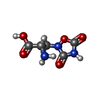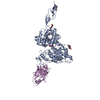[English] 日本語
 Yorodumi
Yorodumi- PDB-7fd8: Thermostabilised full length human mGluR5-5M bound with L-quisqua... -
+ Open data
Open data
- Basic information
Basic information
| Entry | Database: PDB / ID: 7fd8 | ||||||||||||||||||
|---|---|---|---|---|---|---|---|---|---|---|---|---|---|---|---|---|---|---|---|
| Title | Thermostabilised full length human mGluR5-5M bound with L-quisqualic acid | ||||||||||||||||||
 Components Components | Metabotropic glutamate receptor 5 | ||||||||||||||||||
 Keywords Keywords | MEMBRANE PROTEIN / G protein coupled receptors / Signal transduction / Metabotropic glutamate receptor 5 (GRM5) | ||||||||||||||||||
| Function / homology |  Function and homology information Function and homology informationA2A adenosine receptor binding / phospholipase C-activating G protein-coupled glutamate receptor signaling pathway / G protein-coupled receptor activity involved in regulation of postsynaptic membrane potential / adenylate cyclase inhibiting G protein-coupled glutamate receptor activity / trans-synaptic signaling by endocannabinoid, modulating synaptic transmission / neurotransmitter receptor activity involved in regulation of postsynaptic cytosolic calcium ion concentration / positive regulation of long-term neuronal synaptic plasticity / desensitization of G protein-coupled receptor signaling pathway / G protein-coupled glutamate receptor signaling pathway / astrocyte projection ...A2A adenosine receptor binding / phospholipase C-activating G protein-coupled glutamate receptor signaling pathway / G protein-coupled receptor activity involved in regulation of postsynaptic membrane potential / adenylate cyclase inhibiting G protein-coupled glutamate receptor activity / trans-synaptic signaling by endocannabinoid, modulating synaptic transmission / neurotransmitter receptor activity involved in regulation of postsynaptic cytosolic calcium ion concentration / positive regulation of long-term neuronal synaptic plasticity / desensitization of G protein-coupled receptor signaling pathway / G protein-coupled glutamate receptor signaling pathway / astrocyte projection / Class C/3 (Metabotropic glutamate/pheromone receptors) / : / glutamate receptor activity / Neurexins and neuroligins / protein tyrosine kinase activator activity / regulation of synaptic transmission, glutamatergic / positive regulation of calcium-mediated signaling / protein tyrosine kinase binding / learning / dendritic shaft / locomotory behavior / G protein-coupled receptor activity / postsynaptic density membrane / synapse organization / Schaffer collateral - CA1 synapse / cognition / cellular response to amyloid-beta / chemical synaptic transmission / G alpha (q) signalling events / positive regulation of MAPK cascade / dendritic spine / learning or memory / glutamatergic synapse / dendrite / regulation of DNA-templated transcription / identical protein binding / plasma membrane / cytoplasm Similarity search - Function | ||||||||||||||||||
| Biological species |  Homo sapiens (human) Homo sapiens (human) | ||||||||||||||||||
| Method | ELECTRON MICROSCOPY / single particle reconstruction / cryo EM / Resolution: 3.8 Å | ||||||||||||||||||
 Authors Authors | Vinothkumar, K.R. / Cannone, G. / Lebon, G. | ||||||||||||||||||
| Funding support |  India, India,  United Kingdom, United Kingdom,  France, 5items France, 5items
| ||||||||||||||||||
 Citation Citation |  Journal: Cell Rep / Year: 2021 Journal: Cell Rep / Year: 2021Title: Agonists and allosteric modulators promote signaling from different metabotropic glutamate receptor 5 conformations. Authors: Chady Nasrallah / Giuseppe Cannone / Julie Briot / Karine Rottier / Alice E Berizzi / Chia-Ying Huang / Robert B Quast / Francois Hoh / Jean-Louis Banères / Fanny Malhaire / Ludovic Berto / ...Authors: Chady Nasrallah / Giuseppe Cannone / Julie Briot / Karine Rottier / Alice E Berizzi / Chia-Ying Huang / Robert B Quast / Francois Hoh / Jean-Louis Banères / Fanny Malhaire / Ludovic Berto / Anaëlle Dumazer / Joan Font-Ingles / Xavier Gómez-Santacana / Juanlo Catena / Julie Kniazeff / Cyril Goudet / Amadeu Llebaria / Jean-Philippe Pin / Kutti R Vinothkumar / Guillaume Lebon /      Abstract: Metabotropic glutamate receptors (mGluRs) are dimeric G-protein-coupled receptors activated by the main excitatory neurotransmitter, L-glutamate. mGluR activation by agonists binding in the venus ...Metabotropic glutamate receptors (mGluRs) are dimeric G-protein-coupled receptors activated by the main excitatory neurotransmitter, L-glutamate. mGluR activation by agonists binding in the venus flytrap domain is regulated by positive (PAM) or negative (NAM) allosteric modulators binding to the 7-transmembrane domain (7TM). We report the cryo-electron microscopy structures of fully inactive and intermediate-active conformations of mGlu receptor bound to an antagonist and a NAM or an agonist and a PAM, respectively, as well as the crystal structure of the 7TM bound to a photoswitchable NAM. The agonist induces a large movement between the subunits, bringing the 7TMs together and stabilizing a 7TM conformation structurally similar to the inactive state. Using functional approaches, we demonstrate that the PAM stabilizes a 7TM active conformation independent of the conformational changes induced by agonists, representing an alternative mode of mGlu activation. These findings provide a structural basis for different mGluR activation modes. | ||||||||||||||||||
| History |
|
- Structure visualization
Structure visualization
| Movie |
 Movie viewer Movie viewer |
|---|---|
| Structure viewer | Molecule:  Molmil Molmil Jmol/JSmol Jmol/JSmol |
- Downloads & links
Downloads & links
- Download
Download
| PDBx/mmCIF format |  7fd8.cif.gz 7fd8.cif.gz | 312 KB | Display |  PDBx/mmCIF format PDBx/mmCIF format |
|---|---|---|---|---|
| PDB format |  pdb7fd8.ent.gz pdb7fd8.ent.gz | 247 KB | Display |  PDB format PDB format |
| PDBx/mmJSON format |  7fd8.json.gz 7fd8.json.gz | Tree view |  PDBx/mmJSON format PDBx/mmJSON format | |
| Others |  Other downloads Other downloads |
-Validation report
| Arichive directory |  https://data.pdbj.org/pub/pdb/validation_reports/fd/7fd8 https://data.pdbj.org/pub/pdb/validation_reports/fd/7fd8 ftp://data.pdbj.org/pub/pdb/validation_reports/fd/7fd8 ftp://data.pdbj.org/pub/pdb/validation_reports/fd/7fd8 | HTTPS FTP |
|---|
-Related structure data
| Related structure data |  31536MC  7fd9C  7p2lC C: citing same article ( M: map data used to model this data |
|---|---|
| Similar structure data |
- Links
Links
- Assembly
Assembly
| Deposited unit | 
|
|---|---|
| 1 |
|
- Components
Components
| #1: Protein | Mass: 96953.977 Da / Num. of mol.: 2 / Mutation: H350L, N445A, T742A, S753A, T777A, I799A, A813L Source method: isolated from a genetically manipulated source Source: (gene. exp.)  Homo sapiens (human) / Gene: GRM5, GPRC1E, MGLUR5 / Cell line (production host): HEK 293 GNTI(-) / Production host: Homo sapiens (human) / Gene: GRM5, GPRC1E, MGLUR5 / Cell line (production host): HEK 293 GNTI(-) / Production host:  Homo sapiens (human) / References: UniProt: P41594 Homo sapiens (human) / References: UniProt: P41594#2: Sugar | #3: Chemical | #4: Chemical | Has ligand of interest | Y | Has protein modification | Y | |
|---|
-Experimental details
-Experiment
| Experiment | Method: ELECTRON MICROSCOPY |
|---|---|
| EM experiment | Aggregation state: PARTICLE / 3D reconstruction method: single particle reconstruction |
- Sample preparation
Sample preparation
| Component | Name: Human FL mGluR5-5M with L-quisqualic acid and PAM VU0424465, agonist bound state Type: COMPLEX / Entity ID: #1 / Source: RECOMBINANT | |||||||||||||||
|---|---|---|---|---|---|---|---|---|---|---|---|---|---|---|---|---|
| Molecular weight | Value: 0.194 MDa / Experimental value: NO | |||||||||||||||
| Source (natural) | Organism:  Homo sapiens (human) Homo sapiens (human) | |||||||||||||||
| Source (recombinant) | Organism:  Homo sapiens (human) / Cell: HEK293S GnTI- / Plasmid: BacMam Homo sapiens (human) / Cell: HEK293S GnTI- / Plasmid: BacMam | |||||||||||||||
| Buffer solution | pH: 7.4 | |||||||||||||||
| Buffer component |
| |||||||||||||||
| Specimen | Conc.: 2.85 mg/ml / Embedding applied: NO / Shadowing applied: NO / Staining applied: NO / Vitrification applied: YES Details: mGluR5 with L-quisqualic acid and ago PAM (VU0424464) purified in DDM/CHS | |||||||||||||||
| Specimen support | Grid material: GOLD / Grid mesh size: 300 divisions/in. / Grid type: Quantifoil R0.6/1 | |||||||||||||||
| Vitrification | Instrument: FEI VITROBOT MARK IV / Cryogen name: ETHANE / Humidity: 100 % / Chamber temperature: 283.15 K / Details: Blot force was 10, 3.5 seconds blotting time |
- Electron microscopy imaging
Electron microscopy imaging
| Experimental equipment |  Model: Titan Krios / Image courtesy: FEI Company |
|---|---|
| Microscopy | Model: FEI TITAN KRIOS |
| Electron gun | Electron source:  FIELD EMISSION GUN / Accelerating voltage: 300 kV / Illumination mode: FLOOD BEAM FIELD EMISSION GUN / Accelerating voltage: 300 kV / Illumination mode: FLOOD BEAM |
| Electron lens | Mode: BRIGHT FIELD / Nominal magnification: 130000 X / Calibrated magnification: 44500 X / Nominal defocus max: 2800 nm / Nominal defocus min: 1200 nm / Cs: 2.7 mm / C2 aperture diameter: 50 µm / Alignment procedure: COMA FREE |
| Specimen holder | Cryogen: NITROGEN / Specimen holder model: FEI TITAN KRIOS AUTOGRID HOLDER |
| Image recording | Average exposure time: 9 sec. / Electron dose: 67 e/Å2 / Detector mode: COUNTING / Film or detector model: GATAN K2 QUANTUM (4k x 4k) / Num. of grids imaged: 1 / Num. of real images: 14604 Details: Dose rate was 5.894 e/p/s. Total number of frames is 48 and each frame had a dose of 1.39 e/A2 |
| EM imaging optics | Energyfilter name: GIF Bioquantum Details: Imaging was done in EFTEM mode. Images were collected using beam shift in a series of 3x3 holes before stage shift. Active beam tilt compensation was turned on during the acquisition. Energyfilter slit width: 20 eV |
| Image scans | Sampling size: 5 µm / Width: 3838 / Height: 3710 / Movie frames/image: 48 |
- Processing
Processing
| EM software |
| ||||||||||||||||||||||||||||||||||||||||||||
|---|---|---|---|---|---|---|---|---|---|---|---|---|---|---|---|---|---|---|---|---|---|---|---|---|---|---|---|---|---|---|---|---|---|---|---|---|---|---|---|---|---|---|---|---|---|
| CTF correction | Type: PHASE FLIPPING AND AMPLITUDE CORRECTION | ||||||||||||||||||||||||||||||||||||||||||||
| Particle selection | Num. of particles selected: 655344 | ||||||||||||||||||||||||||||||||||||||||||||
| Symmetry | Point symmetry: C2 (2 fold cyclic) | ||||||||||||||||||||||||||||||||||||||||||||
| 3D reconstruction | Resolution: 3.8 Å / Resolution method: FSC 0.143 CUT-OFF / Num. of particles: 118016 / Algorithm: FOURIER SPACE / Num. of class averages: 3 / Symmetry type: POINT | ||||||||||||||||||||||||||||||||||||||||||||
| Atomic model building | B value: 113.4 / Protocol: OTHER / Space: RECIPROCAL Details: Refinement was performed with jelly body restraints | ||||||||||||||||||||||||||||||||||||||||||||
| Atomic model building | 3D fitting-ID: 1 / Pdb chain-ID: A / Source name: PDB / Type: experimental model
|
 Movie
Movie Controller
Controller



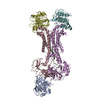

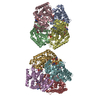
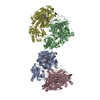

 PDBj
PDBj



